The Art of Yakshagana
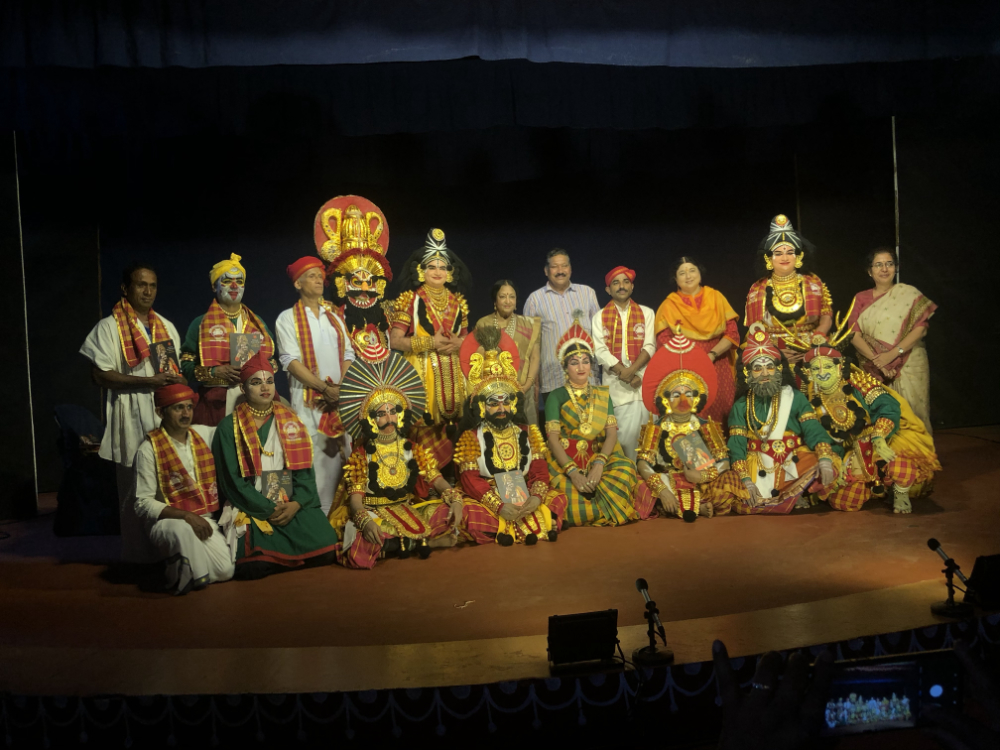
By Mohanapriyan Thavarajah From the travel diaries, here is a first person experience of witnessing the art of Yakshgana and tracing its origin at the Yakshagana village at Karnataka. Mohanapriyan Thavarajah fondly retells, “In the village, I witnessed not only tradition, art, hospitality but also love for humanity. The more I travel, the more I dance, the more I fall in love.” Yakshagana is a theater form of Karnataka (India) that combines dance, music, dialogue, costume, make-up, and stage techniques with a unique style and form to depict stories of the Indian Hindu epics and mythology. This theatrical style, resembling Western opera, is mainly found in the Coastal districts and the Malenadu region of India. Yakshagana is traditionally presented from dusk to dawn. Yakshagana was evolved centuries ago as a theatre art and education to rural mass of India.The tradition of presenting a narrative through mime, gesture, dance, choreography, song, décor and music as a single Dance-Drama has its roots in Natya Shastra. Depending upon the song, actors compose appropriate dance movements followed by impromptu dialogues.Yakshagana has attracted people from all walks of life and all sections of the society irrespective of caste and religion. It is a befitting response for a form of art that upholds humanitarian values. Protected for hundreds of years in remote villages of Karnataka, it is now taking finer shape in the modern world. Yakshagna has mainly been classified into two forms namely Badagu and Tenku tittu (Styles) unique to northern and southern parts of the coastal regions respectively. The performing troupe is called Mela or Mandali which is a traditional repertory and travels from place to place. I had an amazing performance tour experience of travelling to Yakshagana village where the Yakshagana traditional art form has been practised for almost seven generations now. It was a day long trip from Singapore – Chennai – Mangalore to Yakshagana Village. It took four hours to drive from Mangalore Airport to reach this village in the interiors of Karnataka. The serene space of a Gurukulam gives the feel of the rustic experience of the olden days which is rare in today’s practice of Indian art forms. In the hereditary lineage, the art form of Yakshagana was initiated by Late Sri Keremane Shivarama Hegde in 1934. Shivananda Hegde is the sixth generation in the family lineage and the director of Sri Idagunji mahaganapati Yakshagana Mandali – a heritage institution in the village, that provides Gurukula training in Yakshagana. I recall that Sri Shivanada Hegde and his Mandali were invited to perform at the Esplanade theatre for the Kalaa Utsavam Indian arts festival in 2012. During that time I had just arrived at Singapore to work with Apsaras Arts on a children’s production commissioned by Esplanade theatre for the same festival. I was able to watch almost every show including the Yakshagana performance at the outdoors theatre. It was my first ever experience watching a Yakshagana performance. I was mesmerised by the performance and remember taking multiple photos and the sound of thundering applause from the audience in appreciation for the amazing performers. After seven years I was able to witness their performance once again at the Madras Music Academy as part of their annual festival in January 2020. Later, It was a great honour to receive an invitation by Shivanada Hegde to dance at his annual Yakshagana festival. The trip to Yakshagana village became very special as I was accompanied by the legendary Dr Padma Subramaniam, her nephew veena mastro Kannan Balakrishnan and our Artistic Director Aravinth Kumarasamy. After the day long trip we finally reached the village around 8.30pm. It was a buzzing festival with many line up of performances starting at sunset in an outdoor theatre setting. The natural smoke from herbs was kept to ward off the mosquitoes, but I hardly remember being disturbed by any insect bites as I was completely immersed into the performances throughout the night. On the second day we had the great privilege to witness an exclusive Yakshagana performance “Sita Aparahan” – the abduction of Sita performed by brilliant artists of Sri Idagunji mahaganapati Yakshagana Mandali proudly led by the director Sivanada Hegde. They performed in the presence of Dr.Padma Subramaniam, who was honoured that evening with a Lifetime achievement award. The performance was by the most celebrated artistes and they truly lived the Ramayana characters on stage. One of the best performances to remember not just because they are excellent artistes, but for their artistry in bringing drama, music, dialogue, dance and tala patterns together in one place. Dr. Padma Subramaniam had mentioned in her speech that they have performed truly a Bharatha Naatyam bringing out the core principles of Bharatha’s Natya Sastra in their Yakshagana performance. I was emotionally inspired and savoured every single movement that brought goosebumps and touched my senses in rasanubhava. Perhaps my mind and body was sated by the Kashayam – a medicinal herbal drink, which was served to the audience at the start of the performance. Apparently this drink is usually served to detoxify the body and good for health instead of hot chai or filter coffee. After the performance I was eagerly waiting to meet the artists to greet and thank them but they just disappeared to the green room for their prayer. Praying before and after performance has been their practice initiated by their forefathers and has been practiced by the generations of artists even till today. They would offer their crowns and instruments at the prayer to seek the divine’s blessings. This performance of Yakshagana reaffirms the faith that the traditional art forms of India continue to play an important role in keeping alive our rich legacy of storytelling, of epics, of maintaining the traditional form even as they are adapted to new ideas more suited to the contemporary milieu. As many we all know that India is a country that brings the diversity of culture, language and food. A team was dedicated to cook simple nutritious local food like
Sunday Spotlight Series
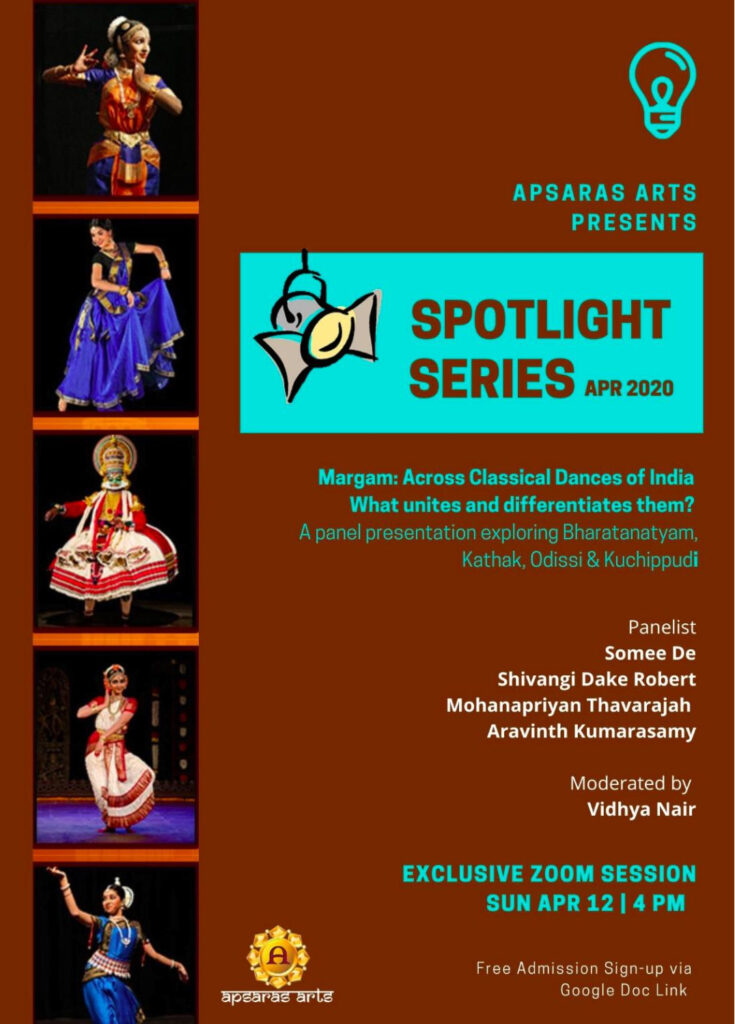
By Vidhya Nair On April 12th, Sunday, Apsaras Arts launched “Spotlight Series” for their students, teachers, parents and Devata partners on the video conference ‘Zoom’ platform. This series aims to provide interactive discussions on a variety of topics with expert speakers in order to create awareness and appreciation of the performing arts practice. The first session was on the topic of Margam or repertoire that is a followed by all the Indian Classicaldances forms. Over the 90 minute session, speakers Soumee De, Shivangi Dake, Mohanapriyan Thavarajah and Aravinth Kumarasamy, covered the basic content, similarities and differences of a repertoire among the four dance forms Odissi, Kathak, Kuchipudi and Bharatanatyam. More than 60 dancers attended this inaugural session. The second Sunday Spotlight series featured eminent dancers from cities in India, Aditi Mangaldas from Mumbai, Priyadarshini Govind from Chennai and Ileana Citaristi from Bhuvaneswar, through the video conference platform. They offered their personal story about their relationships, learnings and blessings from their respective legendary Gurus. Aditi Mangaldas spoke of her two teachers, Smt Kumudini Lakhia, Pandit Birju Maharaj. Priyadarshini Govind narrated her memories of Smt Kalanidhi Narayanan and Dr Ileana Citaristi retold her story of learning from Guru Kelucharan Mohapatra. The three imminent teachers, transformned into their student lives and generously shared details of their relationships with the Gurus who had nurtured them over the years. They highlighted how their Gurus inspired their thinking and at the same time helped them develop their own interpretation and create their own unique practice. More than 70 dancers attended this session and asked questions that ranged from values, respect, openness, relationships and learnings about dance and life. In this latest edition of Apsaras Arts Spotlight Series, three internationally renowned dancers joined to share their dance journeys, shedding light on how they came to pursue Bharatanatyam and Odissi despite not being of Indian-descent. Dr Ramli Ibrahim, a Malaysian who received his Padma-Shri in 2018 shared how he created his own dance company, Sutra Foundation and the challenges he faces in creating multiple nights of sold-out shows without institutional funding but still considers his Malaysian multi-cultural identity as integral to his interpretation of Odissi dance. He spoke about his extensive travels within India learning from several eminent teachers and finding his own voice. This was echoed by Frenchman Dominique Delorme, who shared his harrowing first encounters in India from the funeral pyres of Varanasi and living in squalor conditions while learning Bharatanatyam. He spoke passionately about how he considers dance to be a natural instinctive calling and learning the techniques from eminent teachers like Padma Subramanyam and becoming mesmerised with the artform drew his lifelong admiration. The third panellist was Guiditta de Concini, from Bottega, Italy. Her introduction to Bharatanatyam came to her as an adult and mother of two and subsequent training introduced her to a number of Gurus like C Balagopalan and Leela Samson, who she shared embraced her wholeheartedly and accepted her without judgement or impediment and allowed her to explore her own artistry and she found her knowledge and application grow with various experimental works she was able to create and gain viewership in her hometown of Bottega. This session was attended by over 100 participants from around the world, including Japan, Australia, France, Italy, Malaysia, India and Singapore. Many of the participants were deeply inspired by this session remarking that they were embolden by these international dancers who overcame barriers and became names to reckon with and are performing without inhibitions or cultural barriers. Several rasikas shared that being able to engage with these acclaimed dancers through this online platform is making them look forward to head back to theatres post Covid19 lockdown and the knowledge they are reflecting on through these sessions is enhancing their appreciation for the deep aesthetics of Indian classical dance. To sign up for the upcoming Sunday Spotlight Series in May-June, look out for the Apsaras Arts Facebook page.
From the Bookshelf – May 2020
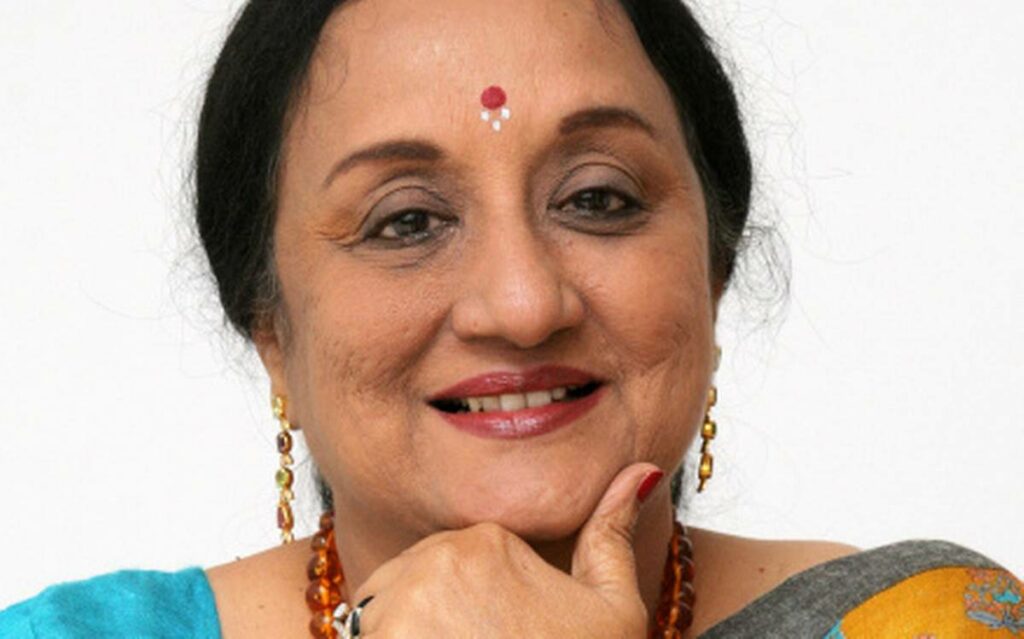
Bharatanatyam – The Tamil Heritage By Nritya Kalanidhi Lakshmi Viswanathan This book gives an overview of all aspects of the richness and beauty of Bharatanatyam through the ages with all that went to influence and shape the Art. The sections of this book is inspired by a book on ballet authored by ballerina Dame Margot Fonteyn. Each chapter connects Bharatanatyam through the ages with early pastoral dances, with the ancient traditions of worship, celebrations of life, Temples and rituals, palaces and kings and patronage and so forth. This book published in 1984 was a product of the author’s research as a junior fellow of the ministry of Culture. The author has traced the roots of Bharatanatyam as a South Indian Art from time immemorial. Thus, each chapter connects Bharatanatyam through the ages with early pastoral dances, with the ancient traditions of worship, celebrations of life, Temples and rituals, palaces and kings and patronage and so on. Many references in old texts like the epic Silappadikaram, and Sangam literature, contextualises the art of dance in society in ancient South India. It takes the reader on a journey of discovery where dance finds inspiration in the old Bhakti poems of saints, the Shaivite and Vaishnavite Nayanmars and Alvars . One also finds the inspiration for sculpture and paintings as seen in ancient temples, linked to Bhakti literature as was the art of dance inspired by the passion of poets. The Cholas, Nayaks and Marathas who ruled Tanjavur left their influence on all the arts including dance. It paints vivid word pictures of the art of dance in the context of Royal dynasties and their patronage through the ages with the epicentre at Tanjavur. Dedicating four hundred dancers to his big temple- the Brihadeeswara of Tanjavur was the early Renaissance of all the arts effected by Raja Raja Chola. Sacred and secular aspects of the art of dance ruled the practice over centuries, with the focus on the dedicated artists, the Devadasis who were the torch bearers of the legacy of music and dance for centuries. Their role in temple and royal court is etched in the history of this art.This book gives an overview of all aspects of the richness and beauty of Bharatanatyam through the ages with all that went to influence and shape the Art. The decline of temple ritual dance and the royal palace patronage brings us to the modern re-christening of the dance as Bharatanatyam. The author has also shared her own experiences of being a student of hereditary Gurus. The chapters is inspired by a book on Ballet authored by the great ballerina Dame Margot Fonteyn. About the author Lakshmi Viswanathan is a Bharatanatyam dancer steeped in the culture of TANJAVUR. She has performed in every major festival in India, and is a regular during the Chennai December season. She has widened her horizon in the field of art by not only performing in India and more than ten countries abroad in prestigious forums, but also uses her erudite scholarship to reach many people with her engaging articles in arts journals, newspapers and dance portals. Her insightful authorship of acclaimed books such as Bharatanatyam the Tamil Heritage, a biography of Bharat Ratna M.S.Subbulakshmi – Kunjamma Ode to a Nightingale, Women of Pride the Devadasi Heritage, and Kapaliswara Temple, have earned her a special place in the world of dance. She is currently editor of the prestigious Kalakshetra Journal. As mentor and teacher she has contributed to the training of students. Her choreographic works like Banyan Tree, CHATURANGA and other productions have been landmark artistic events based on new and original themes. Recently she premiered MY TYAGARAJA – the life of Bangalore Nagratanammal, a famous Devadasi artist , a dance theatre production. A respected artist of the renaissance of dance in India, she brings to her audience, a special amalgam of intellect, innovation and attractive poise. Many awards and titles have been conferred on Lakshmi, including the national Sangeet Natak Akademi award and the prestigious NRITYA KALANIDHI award from the Music Academy Madras recently with the great choreographer Mark Morris of New York as the chief guest.She received the prestigious KALIDAS SAMMAN award recently at the inauguration of the Khajuraho Dance Festival where she performed to an appreciative audience. Noted for her Abhinaya, Lakshmi makes her dance visual poetry with poignancy. Lakshmi Vishwanathan, a prime disciple of Guru Kanjeevaram Elappa Pillai, is an exponent of the Thanjavur style of Bharatanatyam. She is also a trained vocalist. She is the author of several acclaimed books: Bharatanatyam – the Tamil Heritage, Kunjamma – Ode to a Nightingale, Kapaleeswara Temple, Women of Pride -The Devadasi Heritage. Her film ‘The Poetry of Dance’ was commissioned by the Festival of India. The Mamallapuram Dance Festival started in 1991 was Lakshmi’s brainchild. She has served on several arts committees. She has served as Vice President of Music Academy (Chennai) and is a member of South Zone Cultural Centre.
Apsaras Arts is our second home
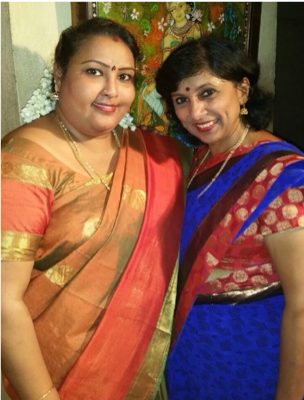
Interview of Ms Selvy Radhakrishnan and Ms Nagaletchimi Balasupramaniam By Aayushi Mehrish Early dancing years Starting her dance training at the age of 5, Ms. Selvy was introduced to dancing with a lot of encouragement by her elder sister, Ms. Rajeswari. Ms. Selvy says, “My first guru was Smt. Devi Maniam. After training under with her for a few years and another teacher named Raju, I stopped dancing for a long time. I used to do a couple of performances and then later came to Mami. I just had a basic knowledge of the art form until I started training under Mami, which started in 1985”. Ms. Selvy also mentioned how her cousin sisters, popularly known as Kesawan sisters (Jeyathi and Sugathi) encouraged her to perform until she joined the Singapore Dance company in 1978 under Madhavi Krishnan. But soon after, a few months later she left when she got married. On the other hand, Ms. Nagaletchimi (Ms. Naga), started dancing at the age of 5 because of her aunt (father’s sister) who nurtured a dream of seeing Ms. Naga as a dancer, when she grew up. She mentioned how it was difficult in the tester years to pursue a profession in dance as women were restricted from performing at public venues. She says, “My father always stopped his sisters to go and dance, but when I was born, my aunts were determined to make me a dancer and grow up to pursue what I really wanted to do.” She mentioned how she later joined Mami in Kallang CC in 1986 where she found her long lost friend, Ms. Vijaya Nadesan (currently Principal of Apsaras Arts) who was her classmate in the preschool years of training under Guru Muthulakshmi (who had relocated out of Singapore). Journey as Students of Smt. Neila Sathyalingam Selvy started her training under Neila Mami in 1985, after the birth of her second daughter in 1983 at the People’s Association (PA), Singapore whereas Ms. Naga joined Neila Mami for Bharatanatyam classes at Kallang CC in 1986 and subsequently at People’s Association in 1988. “I knew Mami as I used to invite her to judge for school arts events. I never knew that one day I would be a part of this company and Mami will be my guru,” says Selvy, remembering her evolving relationship with Mami. Soon after her calibre was recognized and she along with Naga were asked to be part of most productions – folk, contemporary and semi classical performances through PA and Bharatanatyam performances through Apsaras Arts. With extensive dance training and rigorous disciplined practices, both Selvy and Naga grew up to be senior dancers of the company. Soon Selvy started leading the PA group and Naga assisted her after her Arangetram in 1999, soon after which she started a class with 15 students in Kallang CC. Subsequently, known to many as Mami’s ‘leading hands’ backstage, they were trained to tie costumes, do makeup and prepare complex hair styles for all kinds of productions. “We both became coordinators with Mami. It became easy for her to handle all these things once we came on board to manage and she knew how our working style was. There was an interesting relationship between us and our guru. We never argued with her on anything and even if we did have a difference of opinion to do things differently, we would never go against her will.” Naga explained when asked about her relationship with their Guru and mentor, Smt. Neila Sathyalingam. Role as All rounders “We had the time. We were teaching part time in schools. So, we had a lot of time to spend with Mami.” Says Ms. Selvy who mentioned how Mami depended a lot on the duo because other dancers were mostly working and couldn’t commit. “I also got married and had a knee problem” mentioned Ms. Naga, adding to fact that they were the only ones who were available all the time which eventually built a strong bond. Later, in Apsaras, Mami started having a group called “Little Angels”. So Ms. Selvy and Ms. Naga, travelled with this group of Little Angels. “We had a lot of shows in different countries like Turkey etc. where we were handling all their costumes, makeup, hair do, taking care of the children, their accommodation, food etc.” says Ms. Selvy reflecting on memories with Mami to make sure that everything would be handled carefully. Mami eventually gave Ms. Selvy and Ms. Naga major responsibilities when she couldn’t physically handle the pressure. During that time, the number of shows were increased to 25-30 a month and sometimes even 40, leading them to arrange everything while Mami would supervise as she knew what best could be used for what productions. “Even when she is not around, her training and blessings remain with us, and we are still here to do everything we can.” Says Ms. Selvy while reflecting back to the golden times she spent with her loving Guru. Much do we know about their chemistry, Ms. Selvy and Ms. Naga developed a relationship which stands to remain unbreakable solely because of the path they were made to pursue. A path led by their Guru. “Our working style as a two-people team involved a lot of planning and precision. Even though Selvy aka is my senior, we never had this conflict of interest and would agree to each other’s thoughts and ideas to workout things in the best way. An understanding bond is what we developed over these years. This bond has helped us come so far where people can rely on us for all wardrobe related matters.” Ms. Naga explained when asked about brief insights with her memories with senior dancer Ms. Selvy. ‘With having both of you around, I can breathe.’ Said Mami as mentioned both by Ms. Selvy and Ms. Naga. All this while, the duo explained their heart touching moments when they realised their guru was watching them. Ms Naga says, “By the
Virtual Events May-June
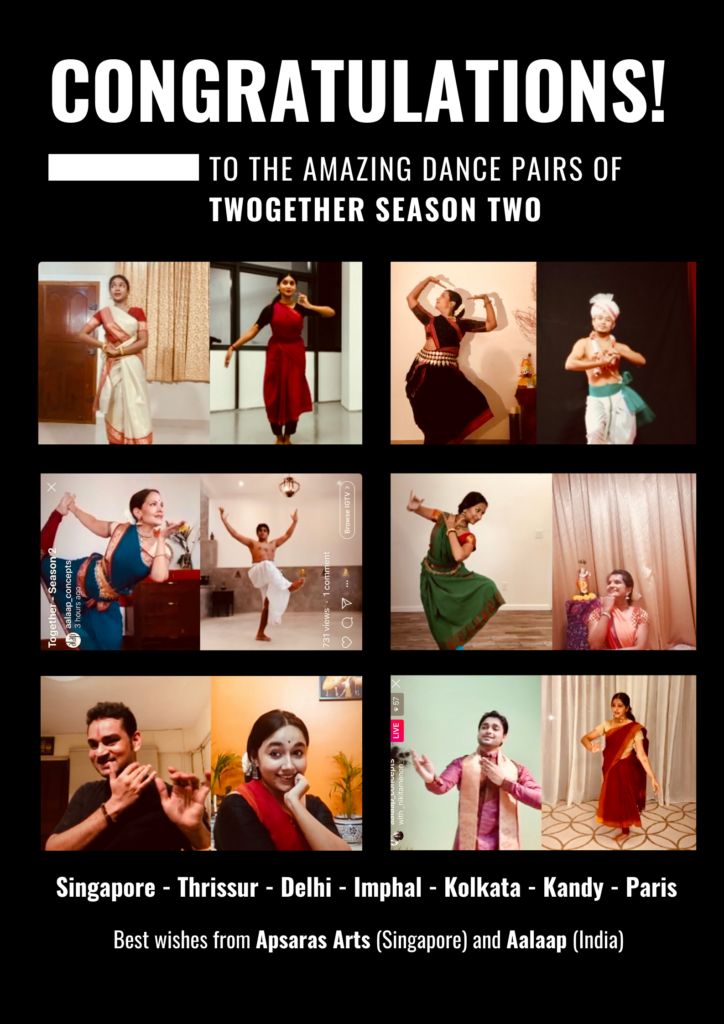
by Vidhya Nair It has been a busy month for Apsaras Arts team over the months of May- June. From in depth interviews and discussions to cross-border experimental collaborations like “Twogether”; from insightful dialogues at the Spotlight Series to solo performances by company dancers in support of worthy cause. Here is a chronology of highlights of the virtual events from our diary over the last 30 days. On 17th May & 31st May – Shukran: A Tribute to Singapore’s Migrant Workers. An initiative by Kathak dancer, Sunena Gupta to create community awareness and outreach through dance. Apsaras Arts’s Kathak dancer/choreographer, Shivangi Dake Roberts performed a segment in episodes 3 and 5. In her segments, she presented invigorating pieces. With her swift movements and crisp turns, these meaningful nritya pieces evoked a variety of moods and expressions. This series gave opportunities to many Kathak, Bharatanatyam and Odissi practitioners to express strength and unity through dance and the fundraising objectives were exceeded. Do watch the episodes here:https://youtu.be/uQStizN00O0 Link: https://youtu.be/6OYmHzjjlgs On 18th May Mohanapriyan Thavarajah was featured at the Home Sketches series @Aalaapconcepts Instagram channel. Aalaap’s theme of Home Sketches featured six dancers reflecting on the idea of home. A place of refuge, an abstract space filled with emotion, feelings and memories. In this session Mohanapriyan Thavarajah engaged in a conversation with Aalaap’s Akhila Krishnamurthy where he hared his memories of growing up in Srilanka, his education in South India and his professional move to Singapore which led to his eventual growth as a dancer while learning to live as a global citizen. For him, wherever dance takes him, it becomes home, a journey which started since he was 14. He felt that he could immediately relate to the Nadanar story for this interpretative performance whose dream destination was to reach Chidambaram where the god of Dance Lord Nataraja resides. This journey was fraught with difficulties being a leather-maker navigating the strict Brahminical society and the perils of the caste system. Ultimately, he proved that he is the beloved to Lord Shiva and there was no one who could stop him from reaching Chidambaram. He immerses himself in his Bhakti for the infinite dancer, Lord Nataraja, reminding us that true love and devotion to ones’ mission can lead us on the path to a blissful heaven. Priyan used verses from Gopalakrishna Bharathi’s Nadhanar Charithram to create this interpretation of home. Many who watched this performance found it profoundly meaningful and a soulful interpretation of Home. On 22nd to 27th May Apsaras Arts in collaboration with @Aalaapconcepts presented a series of duet performances called “TWOgether Season II”. In this season six pairs of dancers from Singapore and India presented duets showcasing the differences and similarities of the different classical dance forms. Bharatanatyam and Odissi dancers from Singapore (Mohanapriyan Thavarajah, Seema Hari Kumar, Nikita Menon, Asvhini Sundaram, Soumee De) and France (Anusha Cherer Duchesne) faced Mohiniattam (Annie Sajayan), Manipuri (Sinam Basu Singh), Kuchipudi (Bhavna Reddy), Odissi (Vrinda Chaddha), Kathak (Souvik Chakraborty) , Kandyan (Geeth Premachandra) dancers from India and Srilanka. Each performance was unique as the duos presented a combination of two or three dance sequences that showcased aspects of their dance forms- nritta, nritya, abhinaya, cultural influences. Over the thirty minutes , of discussion-demonstration, the audiences learnt about the the beauty and uniqueness of each of their dance forms and practices. In this experimental split-screen showcase, the dancer duos leveraged the communication in a way that gave us the impression they were indeed in one room (instead of being miles apart)! Do watch the series on the IGTV channel of @Aalaapconcepts. During the interaction with the audiences, the dancers cited the key challenges they faced which in overcoming the challenges of technology, time lag in music and expressions, getting to know a new acquaintance across borders, understanding each other’s practices and collaborating within 5 days timeframe, adapting to each other’s time-zone. However, each appreciated the opportunity this season offered them to sharpen their own skills and adaptability in times of uncertainty. Many audience members asked about their creative process within the week and their approach to bring synergy to their ideas. The dancers shared that this “twogetherness” imposed greater clarity of collaboration an a disciplined commitment to prepare credible pieces within the short preparation window, helped them overcome the impasse. They also felt that this initiative broke down barriers of distance and helped them reach out to fellow dancers in similar mental and emotional frame during the Covid19 lockdown, bridging this physical gap through dance. From the Singapore audience perspective, it was a rare opportunity to learn up and close about the intricacies of artforms like Mohiniattam, Manipuri and Kandyan dancers. This collaborative concept allowed for intimate interaction with these dancers – their thought process and their willingness to adapt and find camaraderie with a performer based overseas. Hear more about the experiences of the dancers in this video. Add link to feedback video On 6th, 7th and 12th June, Apsaras Arts company dancers, Kshirja Govind, Kritika Rajagopalan and Maanasa Sri Granesh performed on Instagram channel @samarpanaforartsandwellbeing as part of Bloom, Samarpana’s Art-heals series which showcases young talented artistes. The dancers, who performed several jathiswaram and abhinaya pieces, appreciated this opportunity to use dance as a medium to express themselves and keep up their dance practice. Kshirja, an undergraduate who has been actively performing from a young age finds much relief from school stresses and freedom of expression as a dancer and is constantly working on her own choreography. Kritika who moved to Singapore last year from Chennai teaches young students at Apsaras Arts and is finding new paths to her dance journey in ensemble works. Maansa Sri Ganesh has been with Apsaras Arts dance company for the past 3 years and has performed for several of the comoany’s iconic productions and tours. These dancers offer their performances to the cause of raising funds for other artistes who need financial support during this COVID19 pandemic.
Spotlight Series
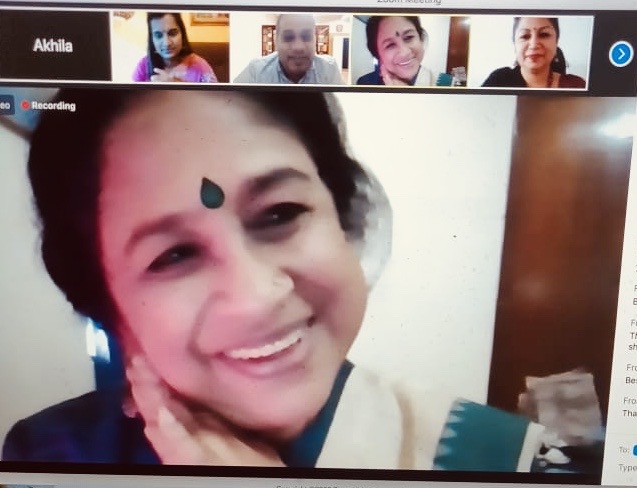
On May 31st, Apsaras Arts held its 4th Spotlight Series Session with Dr Gowri Ramnarayan. In this session on the “Shaping of a Nayika – evolving characters onstage” Dr Gowri Ramnarayan used images from her theatre productions and shared the thought process behind them all. From the techniques used to shape characters such as Yasodhara, the wife of Prince Gauthama to the use of thought provoking monologues by the characters from epics such as Manthara, Urmila, Shantha and Soorpanaga, the lesser known heroines from the Ramayana, tt was an absorbing session attended by over 60 participants. The Q & A helped dance practitioners ask practical questions on how the stage can be used with images of Nayakas through props like cloth, painting, lighting; how to choose appropriate words in scripting and the importance of silence and pause within a performance which creates a powerful experiences for the audience.
Special Feature
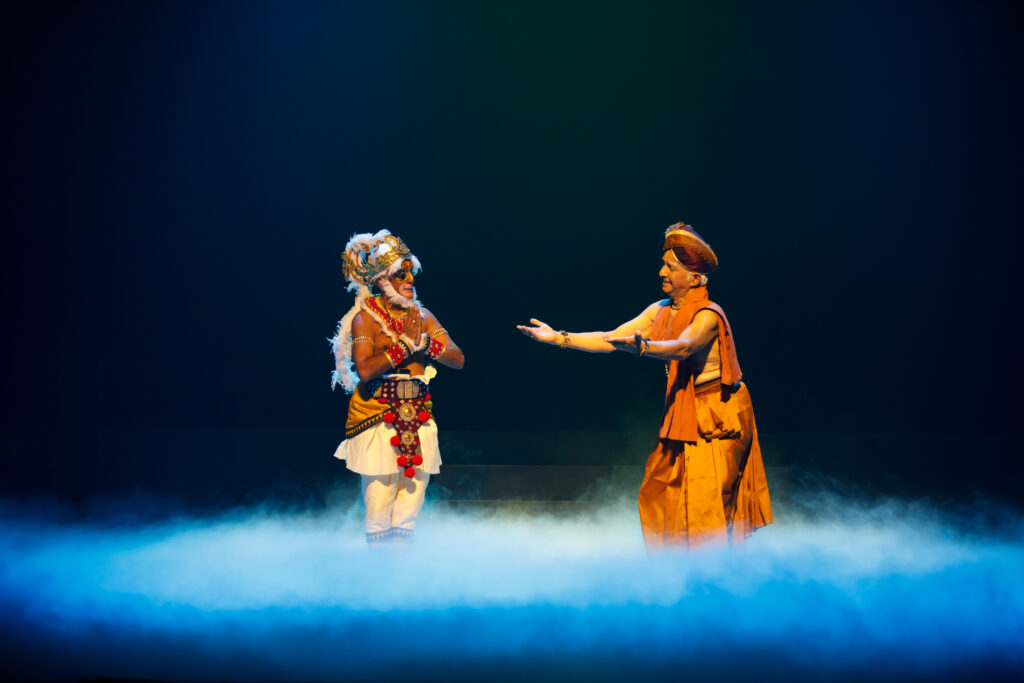
Screening of Anjaneyam- Hanuman’s Ramayana by Esplanade Theatres in collaboration with SISTIC Live From May 24th – 31st, Anjaneyam- Hanuman’s Ramayana, one of the master-piece ensemble productions from 2017 produced by Apsaras Arts was invited to be part of a showcase series by the Esplanade Theatres by the Bay and SISTIC (the largest ticketing platform) for a week long live web streaming. Here is a digest of this memorable week and multiple dialogues that were hosted on social media channels with the Artistic Director, choreographer, set and costume designer to understand the creative process behind this epic production. Apsaras Arts was invited to be part of a joint showcase by Singapore’s Esplanade, Theatres by the Bay and SISTIC (largest ticketing platform in Singapore) for a Live web streaming. The showcases included 3 locally created productions from a diversity of cultures- Chinese, Malay and Indian genres. The production, Anjaneyam – Hanuman’s Ramayana which premiered for November 2017 as part of Esplanade’s annual Kala Utsavam Festival was selected to be a part of this inaugural prestigious feature. Over 8 days, a substantial number of tickets were sold to audiences from Singapore and overseas to watch the entire production from the comfort of their homes. Patrons could avail these tickets at no cost or offer to pay a nominal donation which was presented to support Apsaras Arts during this pandemic. There has also been encouragement for this production in receiving greater international visibility. Digital outreach is the new-normal as arts companies engage with global viewers in times of Covid19. In the course of the week, reflective conversations on the production were organised to provide deeper insights on its creative process. Esplanade hosted a talk on 30 May, where Aravinth Kumarasamy, Artistic Director of this production spoke at length on how this staging was made possible and the long-standing relationship Apsaras Arts has created in collaboration with Esplanade Theatres over the past 15 years showcasing many innovative works. Rajeshwari Ramachandran, Producer Esplanade, said, “It’s a lot of hard work and we are proud of our collaborations with Apsaras Arts with you (Aravinth) and, Mami (late Smt Neila Satyalingam). Our relationship is so precious and these works are so valuable for the company and we appreciate how it has been performed and received in Singapore and staged to audiences all over the world.”https://www.facebook.com/EsplanadeSG/videos/567014130671300 On16th May, @Samarpanafortheartsandwellbeing Instagram channel hosted a dialogue on The Making of “Anjaneya, Hanuman’s Ramayana” by Aravinth Kumaraswamy, Artistic Director interviewed by Chitra Sundaram, Dance-theatre performer, lecturer, dramaturg from London, UK. This hour-long session included a highly interactive audience who posted questions on the creative process for this epic production. Chitra Sundaram posed candid questions on the making of the mega-production covering the genesis of the idea, the text references and how the story culminated into a script. She also asked about the theatrical techniques employed and how Bharatanatyam collaborated with Javanese dance. They shared many interesting anecdotes about bringing legendary dancers VP Dhanajayan and C K Balagopalan who played roles of sage Valmiki and the aged Hanuman respectively. She also asked Aravinth to share what it was like working with the Esplanade Theatre, a much sort-after venue in Singapore. If you are interested in the creative process of a production, don’t miss this insightful conversation. Link: https://youtu.be/lUm2rZOGl80 On 30th May another conversation, “Aahaaryam” was hosted by Akhila Krishnamurthy of Aalaap Concepts featuring Aravinth Kumaraswamy and Mohanapriyan Thavarajah on the design of the elaborate sets and costumes in the Anjaneyam production. In this talk, interspersed with scenes from the production fuelled an interactive Q&A and a comprehensive slide presentation displayed the vision and inspiration behind each design used in this production. Inspirations from Javanese batik, the Balinese representations of the Ramayana using elaborate head-gear, thematic jewellery for King Dasharatha’s Queens and the Apsaras from Sri Lanka, block printing designs from Javanese woodcarvings, recreated an authentic scene with the grandeur enhanced by digitalised paintings as back drop. https://www.facebook.com/v7.0/plugins/video.php?app_id=&channel=https%3A%2F%2Fstaticxx.facebook.com%2Fx%2Fconnect%2Fxd_arbiter%2F%3Fversion%3D46%23cb%3Dfe8d840bf55657edf%26domain%3Dasw.dmv.mybluehost.me%26is_canvas%3Dfalse%26origin%3Dhttps%253A%252F%252Fasw.dmv.mybluehost.me%252Ffdf3edf7c5cc02794%26relation%3Dparent.parent&container_width=740&href=https%3A%2F%2Fwww.facebook.com%2Ftheaalaap%2Fvideos%2F299430271082831&locale=en_GB&sdk=joey&width=825 For information on Anjaneyam, behind the production. Link: https://www.facebook.com/hanumansramayana
A life in Dance
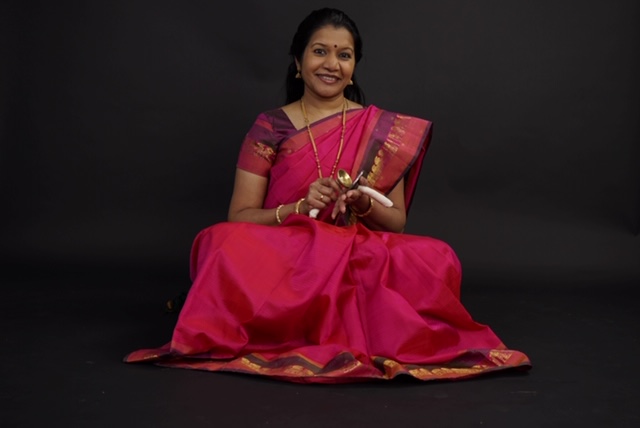
“A life in Dance” – An exclusive interview with Uma Chetty, Artistic Director Apsaras Arts, Virginia USA by Vidhya Nair “For me, dance is where I go to reset, it is my refuge. Dance gives me balance, the equilibrium to live my life. The 4Ds (Discipline, Determination, Dedication & Devotion) are the tenants I believe in and impart to my students as the guidance to take you forward in life.” Uma Chetty (nee Kannappan) has been an advocate of Bharatanatyam for most of her life. Now, living in Richmond, Virginia in the United States, she shared her dance journey and how it has been such a huge force of influence and inspiration in her life. Uma Chetty grew up in Singapore and watched her first Bharatanatyam performance at the Tanglin Club at the tender age of 7 in the 1970s. This dance recital was performed by the daughters of Mrs. Neila Satyalingam (“Mami”). At that age, the visual experience of the costumes, jewelry, eye movements and dramatic make-up completely captivated her and she persuaded her mother to sign her up for dance lessons. She began classes with Mami at Cairnhill Community Centre and over the years, participating in numerous Navaratri programs and school concerts. She recalls performing a “thillana” on television in the programme, “Siruvar Malar” in the 1980s. By 1983, she completed her Arangetram at the age of 14 and the entire Sathyalingam family was on-stage (at Victoria Theatre) supporting her debut performance. Throughout her school years at Raffles Girls and Raffles Junior College, she contin-ued to dance. She was called to perform and choreograph for the Tamil Language Society cultural programs and she actively participated in dance competitions. By the time she completed her un-dergraduate studies at NTU in Accountancy and started work at Ernst & Young, she had become a seasoned dancer. When she met her prospective groom from the US, she was happy to learn that she would receive full support to continue as a dancer. Before she bid adieu to Singapore, she per-formed with her peer, Lalitha Venkatasubramaniam in a duet recital at DBS Auditorium in 1993, again with the guidance and support of Mami and her family. When I asked her about her relationship with Mami, Uma described her with fondness, “She was firstly a teacher who inculcated the love for dance by inspiring you. For Mami, making mistakes was part of learning. It was not necessary to be perfect. She was a very strong lady, someone who dealt with many challenges, yet she was an effective mentor, giving good advice to any issues whether in dance or in life. Uma said that on many occasions, when she turned to Mami for advice, she would offer words of caution and always advocated patience. “Wait it out, Uma,” she would say. When she first landed in the US, she was first at Dover, Delaware, living in a small apartment. At a Deepavali party, she performed and was approached by a few mothers to consider teaching. This was not something she was prepared for or had planned, but she decided to give it a try. Thanks to the copious notes her mother had taken down during her lessons, she initially began with 2 stu-dents that gave her the confidence to pursue dance teaching seriously. By 2000, she had two sons and had embarked on a career in financial services after completing her CPA and MBA. At this junc-ture, she decided to start Apsaras Arts, with the blessings of both Sathyalingam Mama and Mami. She said they were very encouraging of this association and considered her an extension of them-selves, in line with what they had been doing in Singapore to propagate Indian classical arts. Be-sides their mentorship, Uma said, “None of this would have been possible without my husband, Ashok. If he didn’t look after the boys, allow me the breaks to study and pace myself and patiently share the housework and load of the family and home, I don’t think any of this would have hap-pened the way it did.”In the past 20 years, Uma has trained 4 other teachers who now run classes with her, teaching over 200 students. They have now completed 44 arangetrams at Apsaras Arts, Richmond USA. In 2009, she received the “Bharatha Kalai Mani” award from both Mama & Mami in Singapore for her achievements in Bharatanatyam in USA. Reflecting on this award, she recalls that it was a surprise at first, as her institute was only 9 years old then but over the last two decades, the value of this award has served as a significant motivation especially in her role to propagate Bharatanatyam in the US, teaching it with traditional authenticity, maintaining rigor in recital preparations and follow-ing a proper syllabus and examination structure. It was moving to hear Uma share her vivid memories of Mami. “Over the years, when I used to come back to Singapore to visit my parents, I would visit Mami at her home at Sarkies Road. I would always take a lesson from her and wait eagerly for the class to get over simply to stay back and spend time with Mami. She had an infectious sense of humor and we would often share a meal and break into peals of laughter.” Till today, Uma continues her practice of taking classes at Apsaras Arts Singapore with Mohanapriyan Thavarajah as she considers continuous learning a key reason for her longevity as a performer and teacher. For her, Apsaras Arts, Singapore after the founders’ demise continues to remain close to her heart and she feels connected with the current team lead by Aravinth Kumarasamy. Her parents, Mr. & Mrs. Kannappan have continued to sup-port Apsaras Arts, Singapore as Devatas through fund-raising and sharing their philanthropic con-tacts. They were invited as honorary guests at Natya Mela, an Apsaras Arts event in February 2017, the last event Mami attended before her demise in March 2017. Uma Chetty’s dance journey has now exceeded 35 years and as she
Bharatanatyam Evolves From Temple to Theatre and back again
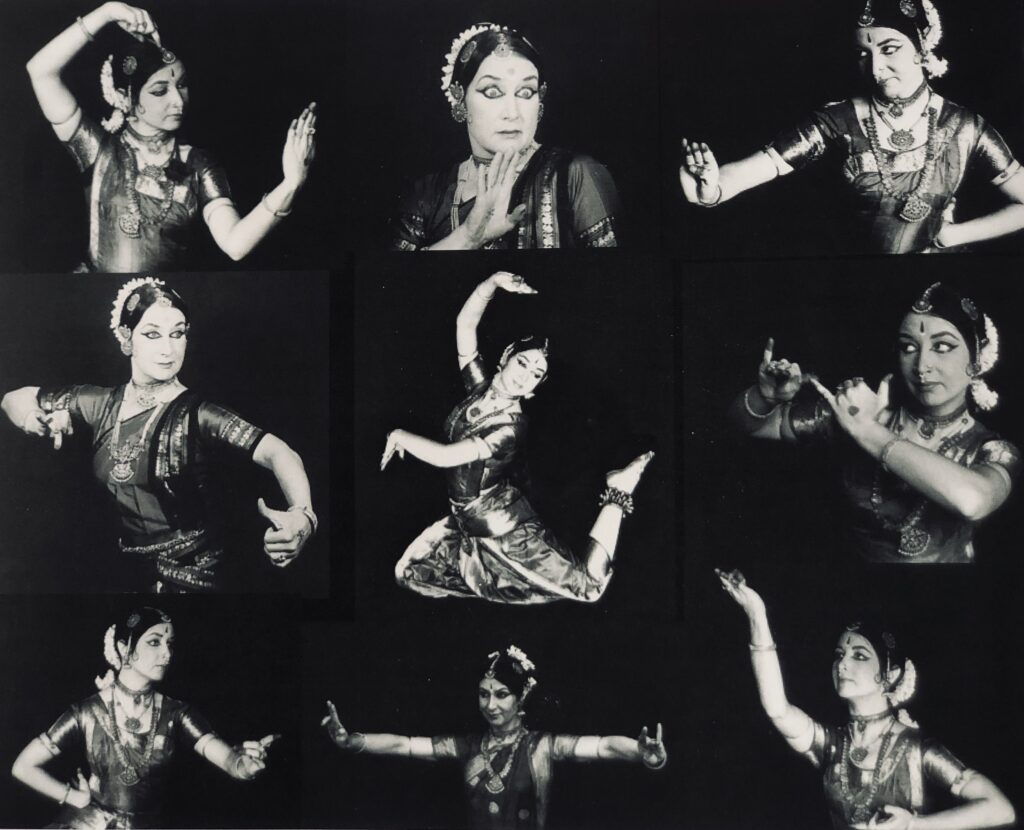
By Anne-Marie Gaston Anne-Marie Gaston (1941-2018) traces the development of Bharatanatyam from its religious and secular roots. She gives details of the teachers who were most influential in the transmission of the dance form from traditional to modern and discusses the role of different interpretations(banis). By describing traditional and modern performances and choreography, she traces changes in the repertoire and presentation that have taken place during the post-revival era. Comments from the author’s in-depth studies of Bharatanatyam as both performer and academic, give a historical perspective to the current manifestation of the dance. Her observations are drawn especially from recitals at the Madras Winter Festivals 2011-15. The volume is profusely illustrated with the author’s own photographs. “In 1964, I began my studies of Bharatanatyam in Chennai with Ellappa Pillai. My performing career in India began in 1966 and in Canada in 1967, presenting the full Bharatanatyam classical margam repertoire. Over the years, this repertoire was collected by studying with several dance masters, male and female, hereditary and non-hereditary. I always saw dance as part of an integrated cultural expression, since it was my visit to the Nataraja temple in Chidambaram where for the first time I saw the karanas on the walls on the gopurams and the huge niche figures of Shiva dancing that first inspired me. Since 1964, I have experienced first-hand the trends and innovations which have taken place within Bharatanatyam and within the landscape of Indian classical dance has a whole. Much of my account is based on personal experience.” “Indian dance has been my lifelong passion. In this book I have drawn on the knowledge I have acquired, as performer, teacher and academic, over a lifetime of immersion in the world of Indian dance. I continue tp be fascinated by the development of Bharatanatyam and other Indian classical styles, both in India and worldwide. Why the basic essence of classical Bharatanatyam has been carefully preserved, much has changed and will continue to do so as the style evolves. It was inspiring and enlightening for me to experience current developments in the dance in Chennai, the artistic center of Bharatanatyam. The many styles of classical Indian dance are very much alive and well. The global stage for this art form is vast and expanding. I hope that the material I have presented will help to uncover some of the forces: cultural, social, political and aesthetic, which have guided Bharatanatyam as it evolves.” About the author Anne-Marie Gaston(1941-2018) studied classical dances and other arts in India from 1964. She had an M.Litt, and a D.Phil from Oxford University Indian arts and taught at Universities and Colleges throughout North America and UK. From 1967 onward, she performed several styles of classical Indian dances(Bharatanatyam, Odissi, Kuchipudi, Kathakali, Chhau and Kathak) extensively in India, Europe and North America, receiving much critical acclaim. Her pioneering work using mixed-media in Indian dance presentations, emphasised the relationships among dance, sculpture and painting. Dr. Gaston, also known as Anjali, choreographed and staged many recitals on non-traditional themes. Her performances can be viewed at www.culturalhorizons.ca. Anne-Marie died at home in Ottawa, Canada, in April 2018.
Awards
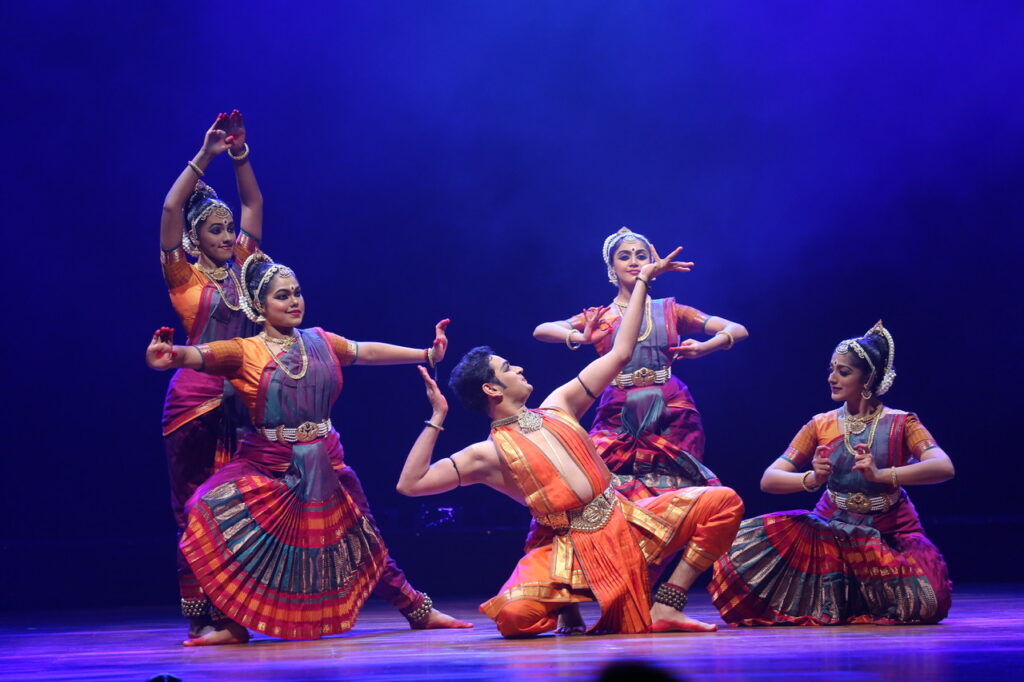
Apsaras Arts receives The Steward of Singapore’s Intangibile Cultural Heritage Award 2020 The month of June began on a momentous note with Apsaras Arts being selected as one of the 6 organisations to receive The Stewards of Singapore’s Intangible Cultural Heritage Award. This award aims to recognise practitioners (individual and groups) of intangible cultural heritage (ICH) who are dedicated to the promotion and transmission of their practices and have made outstanding contributions in their field. This award conferred by the National Heritage Board (NHB) is one of the key recommendations for the safeguarding of ICH, as part of Our SG Heritage Plan, the masterplan for the heritage and museum sector for 2018 to 2022. “We are deeply honoured & humbled, for Apsaras Arts to win this award. This award recognises our Founders vision to create a dance company to celebrate our local dance traditions, and to nurture young aspiring talents to be showcased internationally. This recognition encourages our current generation of art-makers who are striving with our mission. For Indian classical dance to be considered an intangible cultural heritage of Singapore, is a sacred responsibility, Apsaras Arts has immense pride in being its custodian here in Singapore, to hand it down to the next generations of Singaporeans as their cultural heritage and as a living tradition” – Aravinth Kumarasamy, Artistic Director, Apsaras Arts This recognition was covered in a two-page feature in the national paper, Straits Times and will be conferred in person at a later date. In gratitude of the community and to commemorate the 43 years of it’s service at Singapore, a video was released on 9 June 2020 showcasing 43 faces and voices associated with the Apsaras Arts company sharing adjectives that reflect their relationship and what this company means to them. SICH Award 2020 Link: https://youtu.be/idmSmkLxdQE